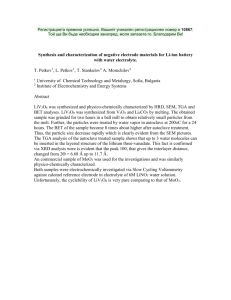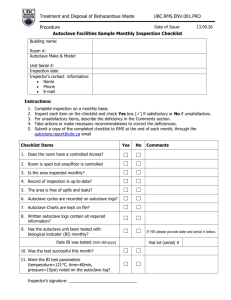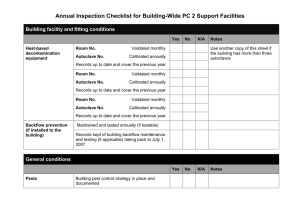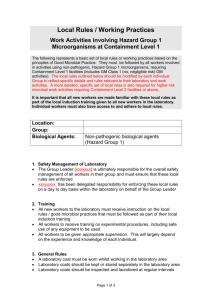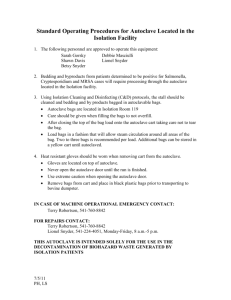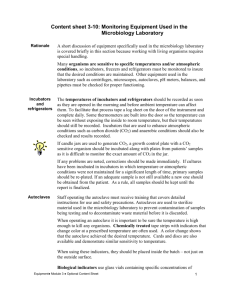SOP034 Experimental Sciences Revision No: Replaces:
advertisement
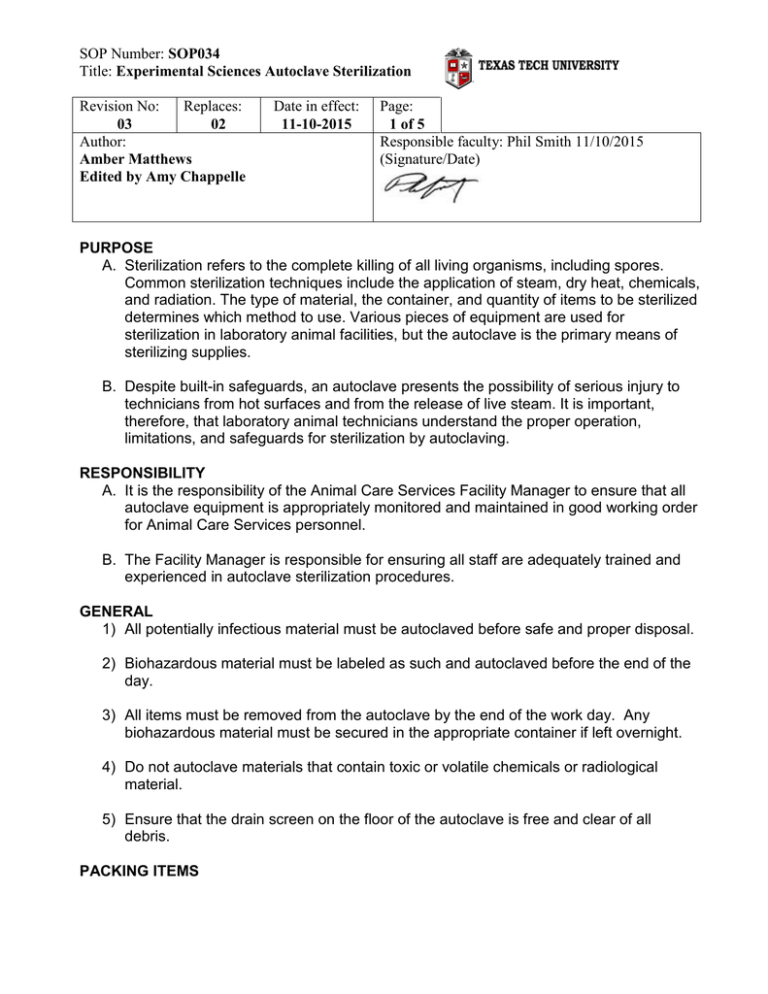
SOP Number: SOP034 Title: Experimental Sciences Autoclave Sterilization Revision No: Replaces: 03 02 Author: Amber Matthews Edited by Amy Chappelle Date in effect: 11-10-2015 Page: 1 of 5 Responsible faculty: Phil Smith 11/10/2015 (Signature/Date) PURPOSE A. Sterilization refers to the complete killing of all living organisms, including spores. Common sterilization techniques include the application of steam, dry heat, chemicals, and radiation. The type of material, the container, and quantity of items to be sterilized determines which method to use. Various pieces of equipment are used for sterilization in laboratory animal facilities, but the autoclave is the primary means of sterilizing supplies. B. Despite built-in safeguards, an autoclave presents the possibility of serious injury to technicians from hot surfaces and from the release of live steam. It is important, therefore, that laboratory animal technicians understand the proper operation, limitations, and safeguards for sterilization by autoclaving. RESPONSIBILITY A. It is the responsibility of the Animal Care Services Facility Manager to ensure that all autoclave equipment is appropriately monitored and maintained in good working order for Animal Care Services personnel. B. The Facility Manager is responsible for ensuring all staff are adequately trained and experienced in autoclave sterilization procedures. GENERAL 1) All potentially infectious material must be autoclaved before safe and proper disposal. 2) Biohazardous material must be labeled as such and autoclaved before the end of the day. 3) All items must be removed from the autoclave by the end of the work day. Any biohazardous material must be secured in the appropriate container if left overnight. 4) Do not autoclave materials that contain toxic or volatile chemicals or radiological material. 5) Ensure that the drain screen on the floor of the autoclave is free and clear of all debris. PACKING ITEMS SOP Number: SOP034 Title: Experimental Sciences Autoclave Sterilization Revision No: 03 Replaces: 02 Date in effect: 11-10-2015 Page: 2 of 5 1) Items to be sterilized should be clean, dry, and placed in the appropriate container, pouches, or cloth wrap/towel packs. 2) For non-biohazardous material, use plain unmarked containers, bags, or pouches. 3) Do not double bag waste or tightly seal any containers as this will impede the flow of steam. 4) Autoclavable bags should never be placed on the floor or touching the sides of the autoclave 5) Biohazardous materials (ie. animal bedding, PPE) should be placed into appropriate autoclavable bags taped with steam indicator tape, but not tightly sealed, as this impedes the flow of steam and decreases the likelihood of complete sterilization. (See SOP035 BSLII Rodent Husbandry). LOADING AUTOCLAVE 1) Each load placed in the autoclave should be positioned so nothing is touching the inside of the chamber. Steam should be able to flow uniformly throughout the chamber and in between items such that no air pockets are formed around or between items. Smaller items to be autoclaved should be bagged or wrapped in heat-resistant plastic, paper, or cloth. Please refer to manufacturer’s recommendations before placing in autoclave. 2) Autoclave should be set at “08-Wrapped 250” for 30 minutes when sterilizing rodent caging. Caging should be set up with bedding and fully assembled, but should not be nested. If caging is stacked, it should be done in such a way as to not impede steam flow. 3) Do not mix loads of liquids and solids. Place auger plates, liquids, or other items that may boil over into shallow pans (less than 1 inch). If a deeper pan is required, please consult the Animal Care Services Facilities Manager. 4) Sterilized supplies must be labeled with date autoclaved/processed. Date of expiration is determined using the following criteria: a. Sterile packs/items should be stored in clean, dry enclosed cabinets and drawers free from moisture and dust. b. Sterile packs prepared by research or technical staff, when stored in enclosed cabinets/drawers in a dust-free, insect-free, and well-ventilated area, can be considered sterile for 1 year providing the packaging remains dry and intact. SOP Number: SOP034 Title: Experimental Sciences Autoclave Sterilization Revision No: 03 Replaces: 02 Date in effect: 11-10-2015 Page: 3 of 5 c. Sterile packs prepared by research or technical staff stored on open shelves have a reduced safe shelf life of 1 month providing the packaging remains dry and intact. d. The manufacturer generally stamps commercially prepared sterilized packs with an expiration date. e. A shelf life of 1 year is suggested for commercially prepared packs without an expiration date, providing the pack is stored in an enclosed cabinet/drawer, remains dry, and packaging is intact. Label commercially prepared packs with the date the item was received. f. The quality of the packaging material, storage and transport conditions, and the amount of handling all contribute to maintaining sterility of the package and its contents. g. Any package that is wet, torn, dropped on the floor, damaged in any way, or past its date of expiration will not be used. When such events occur, the contents should be removed, re-cleaned, repackaged, and re-sterilized. 5) Steam indicator strips should be used in each autoclave load. Place steam indicator strips on the removable shelf next to items to be sterilized. 6) When sterilizing materials using autoclavable bags (with the exception of biohazardous bags/materials), leaving the bag open during the autoclave process will facilitate proper steam exposure throughout the contents of the bag. 7) When autoclaving biohazardous waste: a. Bags/containers should not be overfilled, half to three quarters full is recommended. b. Close the container, leaving enough room to facilitate steam penetration, but not allow the contents to spill out. c. Biohazard bags/containers should be labeled with an autoclave indicator so that it can be readily determined that the container has been autoclaved. For specific procedures of autoclave operation see the Autoclave Operations Manual located in the Animal Care Services Facility Manager’s office. REMOVING ITEMS When the autoclave cycle is complete and the pressure returns to zero the door may be opened. Certain safety precautions should be considered before removing items from the autoclave: 1) Before opening the door, staff members should don heat-resistant autoclave gloves. Press the “OPEN” button on the control panel and move to the opposite side of the door opening in order to prevent being scalded from the steam. Once the door has SOP Number: SOP034 Title: Experimental Sciences Autoclave Sterilization Revision No: 03 Replaces: 02 Date in effect: 11-10-2015 Page: 4 of 5 opened, after a few minutes, the autoclave materials can then be removed. Items will still be very hot for a while. Items should not be used until cool to the touch. 2) Staff members encountering malfunctions with the autoclaves should report it immediately to the Animal Care Services Facilities Manager and should attempt to fix the problem themselves. 3) Unload hot items onto a portable cart for safe transfer. 4) Autoclaved disposable items should be properly discarded. RECORDKEEPING Record the date, time, items sterilized, and initials of individuals conducting the sterilization in the Autoclave Log Book. Results of the Steam Indicator must be attached and recorded to each log. If in the event that a steam indicator does not change colors, notify the Animal Care Services Facilities Manager. Weekly biological SafeStep testing results should be recorded in the comments section along with date, time, and initials of the individual testing. Please refer to SafeStep SOP for full instructions. If the test results in a reading of 45 ATP or higher, immediately notify the Animal Care Services Facilities Manager. SAFETY CONSIDERATIONS A. Technicians can be seriously injured from hot surfaces and from the release of live steam. Use of the long-heat-resistant autoclave gloves is necessary. B. Technicians should never use the autoclaves unless there is another staff member or supervisor present in the building. C. If steam escapes through the gaskets while the autoclave is running, turn the autoclave off and notify the Animal Care Services Facilities Manager. DO NOT OPEN THE DOOR. BIOLOGICAL INDICATORS Animal Care Services Staff in conjunction with Environmental Health and Safety will perform weekly biological testing to ensure that all equipment is working properly. Please refer to the Environmental Health and Safety Standard Operating Procedure for Periodic Autoclave Testing and Reporting for further information. REFERENCES • American Association for Laboratory Animal Science. Training Manual Series, Volume II. Laboratory Animal Technician. SOP Number: SOP034 Title: Experimental Sciences Autoclave Sterilization Revision No: 03 Replaces: 02 Date in effect: 11-10-2015 Page: 5 of 5 AUTOCLAVE OUT OF SERVICE It is the responsibility of Animal Care Services Staff to report a malfunctioning autoclave immediately to the Animal Care Services Facility Manager or Building Manager A. PLAN 1. Autoclaves in other parts of the building can be used when the ACS autoclave is not functioning. 2. Autoclaves are located in room 07, room 214 and room 310. 3. Follow all corresponding SOPs, if available, for operating any autoclave in the building. 4. Be considerate of other people needing to use these autoclaves. B. PROCEDURE 1. Animal Cages a. The bedding of contaminated rodent cages will be emptied under a biosafety hood in the animal room into autoclavable biohazard bags. The cages and other items will be sprayed with Clidox solution (mixed according to manufacturer’s instructions), allowed a 10 minute exposure time, and taken directly to the dirty side washroom. The cages/items will then be sanitized in the cage washer. 2. Biohazard Waste a. After the waste has been dumped into autoclavable bags, the bag will be secured with autoclave tape, leaving a steam opening and then will be sprayed with Clidox (mixed according to manufacturer’s instructions) upon leaving the animal room. Allow a minimum of 10 minutes saturation time for the Clidox. The bags can be stored in marked containers in the dirty side washroom and carted in these sealed containers to another autoclave in the building. Any questions or concerns should be directed toward: A. Sydnee Woodman, ACS Facilities Manager 806-834-2872 Office 602-758-0670 Cell Phone B. David Dorsett, Experimental Sciences Building Manager 806-834-2648 Office


